How to change your front disc brakes
Hello all, ok it might be simple to some but some has no idea how to change something simple as their own brakes. Why pay for something when you can do it yourself some may ask....why not pay someone to do it? Well at least I got the satisfaction of seeing my own handy work and knowing the new brake was actually fitted.
Ok obviously you have to take the wheel first off. I jack it up using the std issued jack and put tressels underneath each side of the two wheels just to make sure nothing happens.

Here you see the side view of the caliper showing the two bolts that hold everything together.
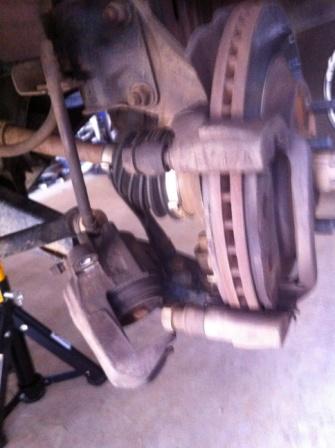
After loosing the two bolt the caliper just slides out, make sure you put it out of the way as it will irretate you soon enough
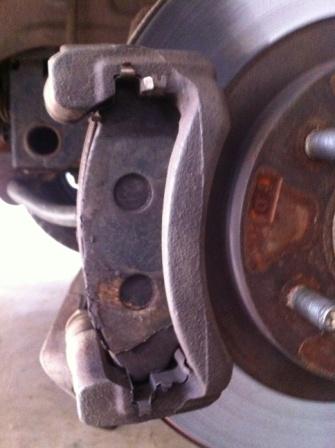
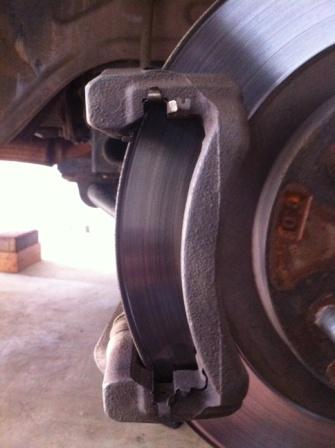
With and without the brake pads in the housing. Both side should slide out very easily but make sure you put the steel clip back the way they got out. Try to keep them inside the housing if possible.
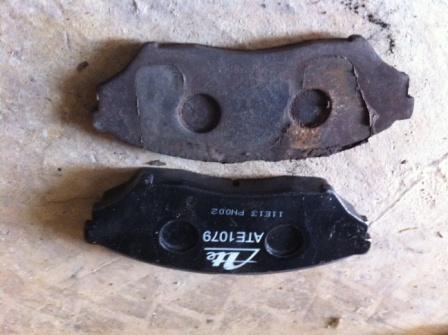

The sets on the left is the front (facing you) and the one on the right is the back pad with the steel plate on it. Make sure you do not loose it as its one of those parts that has to go back inside. HA HA
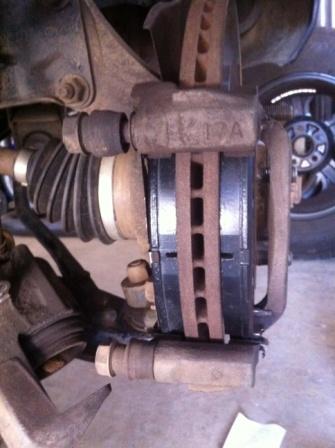
Here its just showing the new sets in the housing.

Here is the booster that fits over the two shoes. Ok here is the tricky part, there is no chance in hell you will get this back without pushing the cylinder back....but wait folks there's more you will not get the cylinder back if you do not slightly release the brake fluid pipe nut at the back of the cylinder. As soon as you start pushing the cylinder in the fluid will start leaking out as it releases the pressure. I used the shock strut as a back board to push it in as it not that easy.
When its completely completely pushed in, slide it over the brakes and using the two bolts tighten the complete assembly. As always you have to bleed the brakes but that is basically how you change your IO brakes. Hope this helps!!!!
O yes before I forget, the two nuts holding the cylinder has rubbers covering the shaft as it pushes in and out to compensate for the brake pads getting smaller. make sure that the rubbers are always nicely in place as the mud and ^*#^@*^ will go in there and you struggle to get the bolt loose again because it has to push back in when you put new ones in.
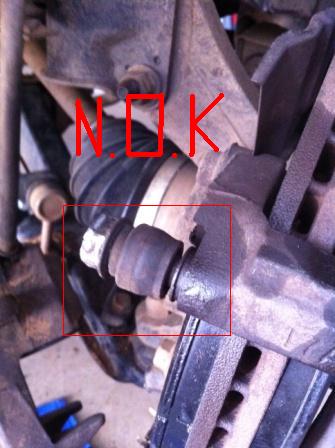
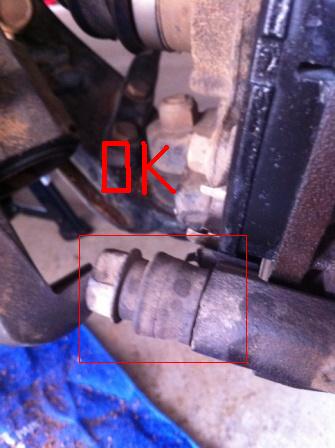
front brake pad
While there is very good saving to do your front brake pad yourself (i am talking in general...), I would be very careful for anyone with no mechanical knowledge to do that. It is true that it is easy, but it can easily go very very wrong:(.
I will add a few advices. Don't let the brake caliper hanging on the hydraulic hose (and check for any crack on them), rince all spilled brake fluid as it is very corrosive (garden hose at the end), clean the contact where the brake pad move (top and bottom, where the clips goes) and add a smear of grease, replace the brake fluid as advised by your manual, check that the caliper does slide properly ( especially if one pad, on the same side, show more wear than the other), make sure that your disc are not undersize, do one side at a time (you can compare if you forget one thing).
On mine I add a special spay glue at the back of the pads, it does help the pad to move back away from the disc, and can be very helpful to remove some unwanted noise.
There is another way to push back the piston, I have a special tool for that, but it can be done while the caliper is still on, and using a couple of large flat screwdriver between the old pad and the disc. Open the brake fluid reservoir while doing so and check the level of the brake fluid, it may overflow (remove some with a syringe, if needed).
I may have missed a few thing...just be extra careful...
Happy io.
Yes the process is very
Yes the process is very simple & quick, my problem came in where the rubber got off the stud and mud got inside it so when i wanted to push the stud back it wat stuck. What should have been a 5min job ended up 1 hour, alot of frustration and two beers. HA HA
To add to Claude's comments.
When pushing the piston back into the caliper, my preference is to "slacken" the bleed nipple (visible in the very first picture, about 1 cm below the top red arrow), so that the fluid is expelled from the system and not forced backwards through to the master cylinder reservoir - this can be especially important on vehicles fitted with ABS brakes - the fluid in the back of the caliper is often dirty & laden with rubber debris which can block the passages in the ABS system.
There are also "rubber safe" greases available that can be used to lubricate the caliper slide pins.
wow.
I've not heard about the fluid becoming acidic and eating the rubbers, but it is hygroscopic (absorbs moisture) which lowers the boiling point and allows rusting within the wheel cylinders & calipers.
What I have seen have been rusted wheel cylinders with the rust pits wearing the sealing edge of the rubbers and causing leaks - or - swollen seals due to contaminated fluid.
brake fluid
I googled "acidic brake fluid" ( wasn't sure why it become that way) and I found that the fluid become acidic because of the condensation going into the brake fluid. He is talking about different types of brake fluid too, interesting....
http://www.200mph.info/info%20brake%20fluid.htm
Do you think that places where humidity is higher (more condensation?) , should replace they brake fluid more often?
Happy io.
I wouldn't pay him too much heed.
I found enough crap in the first paragraph alone to make me doubt that he's doing anything more than regurgitating stuff he's found elsewhere on the internet AND misquoting his sources.
Feel free to try the experiment in the last paragraph, see if you can match his results.
as an experiment get half a bottle of fluid and mark the level - take the top off and leave in the open air for an hour - come back and recheck the level it will have gone up from the absorption of incidental moisture in the air! Overnight it would probably over spill!




Good information.
I only just did this the other day for the first time, replacing the pads that have been in there since the beginning. After my mechanic serviced the car at the 190,000km mark, he informed me after the service that i had only 1mm left on my brakepads!! I changed these out pretty quickly, and set some new ones in.
The process is pretty simple when you do it by yourself, as they just click straight back in. It is exactly as you said...